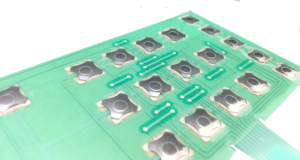Discover How a Membrane Switch Boosts Resilience and Functionality in Devices
Discover How a Membrane Switch Boosts Resilience and Functionality in Devices
Blog Article
Understanding the Functionality of Membrane Layer Switches for Interface Devices
The capability of membrane switches stands for a considerable development in interface style, integrating performance with visual flexibility. These buttons operate via a multi-layered framework that translates customer interactions right into electrical signals, permitting for both small formats and durability versus environmental factors. As markets increasingly focus on user experience, comprehending the nuances of membrane layer button innovation becomes necessary. What implications do these innovations hold for future applications, and how might they redefine customer interactions across numerous gadgets?
What Are Membrane Switches?
Membrane layer buttons are cutting-edge user interface gadgets that assist in individual communication with digital tools. These functional parts include numerous layers, consisting of a visuals overlay, spacer, and a published circuit layer. The style enables a smooth assimilation into various digital gadgets, improving both the aesthetic and practical facets of individual interfaces.
Membrane layer switches are generally utilized in a vast array of applications, from household appliances to commercial machinery and clinical gadgets. Their building commonly features a slim account, making them an excellent selection for small styles. The tactile responses supplied by these switches can be engineered to meet details customer preferences, guaranteeing effective interaction in between the individual and the device.
Longevity is one more significant benefit of membrane layer switches, as they are immune to dust, wetness, and chemicals, which boosts their life-span sought after environments. In addition, these buttons can be customized in regards to shape, size, and visuals design, permitting branding and user-specific functions. In general, membrane layer changes represent a sensible option for improving customer experience in digital gadgets, integrating performance with aesthetic charm in an efficient fashion.
Exactly How Membrane Changes Work
Operating on an uncomplicated concept, membrane layer changes utilize a split building to sign up individual input effectively. Each button contains multiple layers, including a published circuit layer, a spacer layer, and a top visuals layer, which are created to interact effortlessly. When a customer presses the leading layer, it compresses the spacer layer, bringing the conductive aspects of the circuit layer right into contact with each other.
This contact develops a shut circuit, signaling the gadget to implement a certain feature. The design enables different arrangements, including tactile responses, which can improve the individual experience by providing a physical sensation upon activation. The materials used in membrane layer switches frequently include versatile substratums, such as polyester or polycarbonate, which guarantee toughness and strength against deterioration.

Secret Advantages of Membrane Switches

Another substantial benefit is their compactness. Membrane layer switches are slim and lightweight, which makes it possible for suppliers to save room in their gadgets without sacrificing capability. This function is specifically helpful in applications where weight and volume are essential considerations.
In addition, membrane buttons are resistant to dirt, moisture, and chemicals, boosting their sturdiness. This strength prolongs their life-span and decreases the demand for frequent substitutes, resulting in expense financial savings in time.
In addition, the tactile responses provided by membrane layer buttons can be enhanced to boost user communication. They can consist of attributes such as elevated buttons or audible clicks, boosting functionality and individual experience.
Applications Throughout Industries
User interface tools utilizing membrane layer buttons prevail in a broad selection of industries, showcasing their adaptability and performance. Membrane Switch. In the clinical sector, membrane switches are important to tools such as diagnostic equipment and client surveillance systems, where their resilience and simplicity of cleaning are vital for preserving hygiene standards. Likewise, in the vehicle sector, these buttons are used in control panel controls and infomercial systems, providing a sleek and modern interface for individuals.
In addition, the consumer electronics sector benefits from membrane switches in home appliances and portable devices, where small layout and easy to use interfaces improve individual experience. Industrial applications additionally leverage membrane switches for control panels in equipment and automation systems, stressing their robustness and resistance to severe atmospheres.
In the aerospace and protection industries, membrane layer buttons are used in cockpit controls and devices, where reliability and performance under severe conditions are critical. Furthermore, the pc gaming sector increasingly incorporates membrane layer buttons in controllers and game machines, adding to an appealing user experience. Overall, the flexibility of membrane layer switches over enables their widespread usage throughout many fields, highlighting their value in contemporary user interface design.
Future Trends in Membrane Layer Change Technology

In addition, making use of sophisticated products, such as polycarbonate and polyester movies, is anticipated to rise, offering improved sturdiness and resistance to environmental stressors. These materials add to the total long life of membrane switches, making them suitable for harsher industrial applications.
Additionally, the unification of clever this modern technology, consisting of IoT connection, will certainly enable membrane switches to communicate with other devices and systems, helping with a much more interactive individual experience. This pattern lines up with the growing demand for wise gadgets across various industries, from health care to consumer electronics.
Lastly, customization options are anticipated to expand, allowing manufacturers to create bespoke solutions customized to details customer demands and choices. These advancements will position membrane layer buttons as crucial parts in look at here the advancement of customer interface modern technology.
Verdict
Finally, membrane changes represent a crucial innovation in customer interface innovation, using a trusted and flexible service for diverse digital applications. Their split building helps with compact layout, while functions such as tactile responses improve individual communication. The toughness against environmental factors better solidifies their energy throughout multiple markets. As developments in product scientific research and touch sensing technologies proceed, the functionality and applicability of membrane layer switches are anticipated to expand, enhancing their importance in modern-day electronic tools.
Report this page